Wasabi is known across the world as a condiment for sushi. It only grows under highly specific conditions, and, most of all, it needs clean, running water. For four centuries, producers have cultivated the delicate plant in stepped fields that their ancestors constructed with stone. Today, however, fresh wasabi roots have largely been replaced by cheaper pastes and powders.
Wasabi in Japanese History
Excavations of archeological remains have revealed that Japanese ate wasabi (wasabia japonica Matsumura) as early as the Jomon period (around 14,000 BC to 400 BC). Having discovered its anthelmintic and sterilizing effects, they ate small-rooted sawa wasabi (water-grown wasabi) that grew in mountain streams as medicine. According to the book Wasabi no subete (All About Wasabi), a late-seventh-century wood strip suggesting the existence of an herb garden was unearthed in 2001 at the ruins of Japan's ancient capital in Asukamura, Nara Prefecture. On it was a series of kanji characters signifying "wasabi."
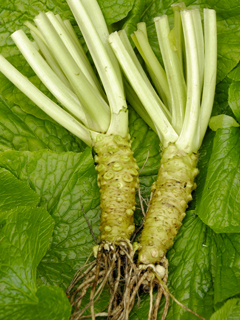
Opinions remain divided as to where wasabi was first cultivated, but Utogi, a mountain village in the upper reaches of Abe River in Shizuoka Prefecture, is considered the likely origin. The story goes that, during the Keicho era (1596-1615), a villager brought home wild wasabi plants from Mt. Wasabi, the source of Utogi River, and replanted them in the village spring. In time the roots grew large, and other villagers who saw this also began growing the plant. Even today the small field where wasabi was allegedly first cultivated is preserved in Utogi.
In 1607 wasabi plants were presented to Tokugawa Ieyasu, who had moved into Suruga Castle in present-day Shizuoka Prefecture after retiring from his position as shogun. Ieyasu highly prized the wasabi due to its connection with the plant Asarum caulescens. The kanji characters for "mountain" and "asarum" are used together to signify wasabi, presumably because wasabi leaves resemble asarum leaves, which are featured in the family crest of the Tokugawa clan.
Wasabi gained prominence with the development of sushi. For centuries sushi referred to nare zushi, made by fermenting fish and rice for two to three months. But a method of fermenting sushi overnight was invented in the 1780s, and several decades later there appeared an unfermented type of sushi made with fresh fish caught in Edo Bay (Tokyo Bay). Wasabi root came to be preferred as a flavoring that counters the smell of raw fish with its hot vapors that sting the nose, enhances the appetite, and prevents food poisoning. It also grew into an indispensable condiment for buckwheat noodles, a commoners' food. Wasabi cultivation took off across Shizuoka, and wasabi came to be actively traded in markets.
Rise of Cheap Substitutes
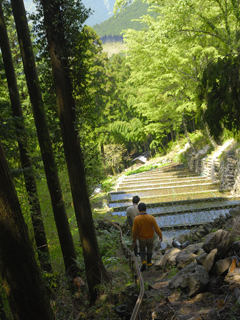
Today, farms growing wasabi are gradually decreasing. The greatest reason is that the majority of wasabi pastes and powders, which are commonly used in the home as well as overseas, use imported horseradish or wasabi. The annual production of processed wasabi comes to about 1,000 tons, two or three times the volume of fresh wasabi. Even fresh wasabi has been imported from Taiwan and China since the 1970s. After the collapse of the bubble economy in 1991, moreover, many of the restaurants that had been using costly fresh wasabi roots switched to cheap processed wasabi, so the demand for fresh wasabi is not growing.
Another problem regards farm size. Because spring water is essential for growing wasabi, wasabi farms are concentrated in mountainous areas, where the farms are inevitably "small-scale farms" by national standards. Under the Food, Agriculture, and Rural Areas Basic Act enacted in 1999, which focuses on farms of 4 hectares or more, wasabi farms across Japan are too small to receive subsidies. Even the largest of them, which owns wasabi fields in both Utogi and Yamanashi Prefecture, has a total acreage of no more than 0.6 hectares. The wasabi fields of the approximately 130 members of the association of wasabi farmers in Abe (the upstream Abe River area, including Utogi), comes to only about 15 hectares. This figure was 20 hectares until several years ago; more and more wasabi fields in the mountains are being abandoned and left to ruin.
Heavy Labor and Sophisticated Skill
A trip to the wasabi fields brings home the sophisticated skill of wasabi farmers. Generations ago their ancestors cleared the dense forest, dug into the stony earth of the mountain, drove wedges into the rocks to break them, carried stones from the banks, and so constructed magnificent stone-lined fields on treacherously steep slopes. Wasabi farmers used to take photographs of newly completed wasabi fields and send them to their relatives and friends. They clearly took pride in the fields into which they had put so much labor.
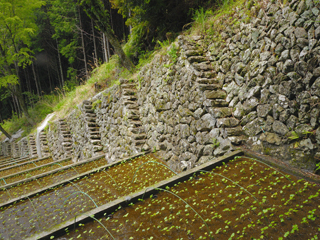
Even today, maintaining and repairing the masonry is an indispensable skill for producers of water-grown wasabi. The wedges have long since been replaced by drills, but the drilling machines weigh close to 20 kilograms, and making and maintaining a wasabi field remains heavy work.
Wasabi cultivation also requires post-harvest "washing" of the soil. The risk of disease rises when accumulated organic matter, such as clay, dead insects, and decayed leaves, stagnates the flow of the water. To prevent this, the surface soil is turned over and carefully washed with a sprayer.
There are several different types of wasabi fields. In Yamaguchi, Shimane, and Hyogo Prefecture wasabi is commonly grown in keiryu style fields, made along mountain streams. An improved version is the jizawa style, which was invented in Abe and is still seen in the Okutama area of Tokyo and in Yamanashi Prefecture. But as both of these styles do not yield uniform growth and the harvest volume is not large, the tatami-ishi style was created near Mt. Amagi in Izu, Shizuoka Prefecture. As Yoshinori Hoshiya writes in his book Wasabi, a tatami-ishi style field is deeper in construction than that of the shallow jizawa style. Large stones are laid in the bottom, followed by a layer of smaller stones, which is topped with a plow layer about 15 centimeters deep. With good drainage and plenty of water, fields of this style are able to produce high-quality wasabi.
Wasabi Cultivation
Takahiro Ozawa and his son took us to their wasabi field. But as they made sure to note, "Every wasabi farm has its own cultivation method that's been handed down in the family, so each family grows wasabi using a very different method."
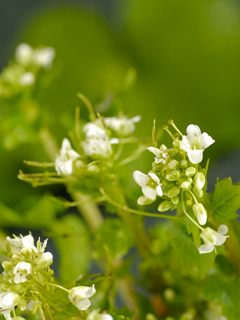
Wasabi plants produce small white flowers between March and April. Long vines hanging down the stone wall are harvested for the seeds, which are cased in pea-like pods. The seeds are stored in a humid environment, being vulnerable to dryness. The seedlings are grown in greenhouses for 2 to 3 months. The Ozawas say that only about 70 percent uniformity in size and shape can be attained at best with plants grown from harvested seeds. The seedlings are then replanted in wasabi fields, where they are grown for another 11 to 18 months. Two-year wasabi roots take time to grow but have superior flavor and aroma.
Once harvested, the discolored stems and leaves are removed while still out in the fields. Then, with the help of the entire family, the plants are sorted, removed of the fibrous roots and worm-eaten parts, and trimmed. The leaves and fibrous roots are not discarded, however. The leaves are delicious boiled and seasoned or as tempura, and the fibrous roots are shipped out for use in such processed products as wasabi paste.
"The number of wasabi growers is small, partly because the plants only grow in highly selective environments," say the Ozawas. "Due to this, not much research has gone into wasabi, and there may actually be as many varieties of wasabi as there are wasabi farms." Moreover, many of the farms grow several different varieties.
Good Water for Good Wasabi
A number of factors affect the flavor of wasabi, including water quality, water temperature, stones, insolation, and the presence of organic matter. But the correlation between these factors and the growth of wasabi is as yet unclear, and further research is to be awaited.
The key to growing good wasabi is controlling the flow of water. A sufficient volume of water must flow evenly. In places where there is not enough water, as well as in years of insufficient water, the roots do not grow large, and the harvest volume goes down. Also, wasabi does not grow well in places where the water splashes, so in the old days this was prevented by inserting cryptomeria branches in the stone wall in stepped fields.
The water must be spring water, with little temperature variation year-round. The ideal temperatures are between 11 and 19 degrees Celsius. Wasabi is fairly resistant to cold, growing naturally as far north as Sakhalin, but it will freeze if the temperature falls to 5 degrees below zero. To keep them from freezing, therefore, the plants are covered with nets in the winter. In the summer they need to be shaded, as they are susceptible to heat and can die out in no time. Alder and other trees are planted for natural shading. In the coming years, wasabi farms in Shizuoka Prefecture and in western Japan will be hard put to find ways to cope with global warming.
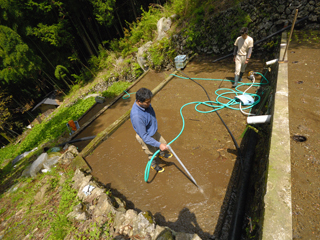
"Wasabi is grown with only water and no fertilizers, so the quality of the water is all-important," explains Takahiro Ozawa. "There's just no way of beating a farm blessed with excellent water. That's why I'd say that the first and foremost condition for growing good wasabi is that your predecessor has left behind a prime location." The wasabi of Gotenba, which is a regular winner in food quality contests, is grown with the plentiful subsoil water flowing from Mt. Fuji.
As wasabi is cultivated in flowing water and the effects of the water on the environs can be profound, the use of pesticides is mostly prohibited. Several years ago, for instance, trout farms suffered damage from the pesticides used by upstream wasabi farms in Nagano Prefecture. Pesticides for expelling plant lice have recently been exceptionally permitted, but they are rarely used in Abe, where plant lice have not posed a problem. Rather, the pests for local wasabi farmers are stoneflies and other insects that inhabit streams. They can go so far as to wipe out the harvest, and the bad news is that there is nothing to be done about them.
Stone and sand gravel, over which water can flow smoothly, are suited for wasabi growth. But a moderate amount of organic matter is needed as well, and too much sunlight is detrimental. The best location, then, is a place surrounded by deciduous trees and aged cryptomeria trees. Hidden among the trees, wasabi fields are beyond public view for the most part.
Rural Depopulation and Urban Diets
The mountains from which the Abe River flows, with the Akaishi Mountains close at hand, are a major source of water for the residents of Shizuoka Prefecture. It is a region that has seen serious flood damage roughly every 30 years. Each time the wasabi fields have been swept to ruin, and each time villagers have joined hands to reconstruct them. Wasabi represents a dietary tradition that has been nurtured by generations of people who have coexisted with nature in all its manifestations.
About 10,000 people used to live in the Abe district, but today that number has halved. While continuing wasabi production is a certainly concern, locals face the more basic question of whether or not they will be able to continue living here. Depopulation in mountainous areas is linked in no small way to the diets of people across Japan. As it is difficult for new entrants to begin wasabi production, which takes place on steep slopes deep in the mountains and does not pay well, it is important for consumers to support wasabi farmers who are currently in the business by buying their products.
Photos: Kazuo Kikuchi
